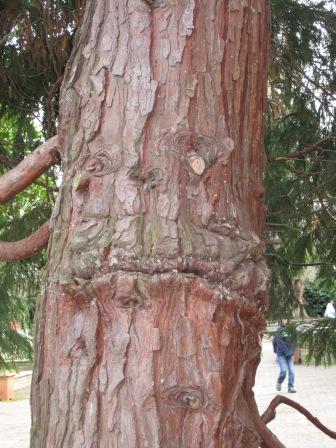Why is this western red cedar (Thuja plicata) so angry? (Hopefully you can see the two “eyes,” nose and mouth.)

Answer on Monday!
Advancing the science of gardening and other stuff since 2009
Why is this western red cedar (Thuja plicata) so angry? (Hopefully you can see the two “eyes,” nose and mouth.)

Answer on Monday!
Dr. Linda Chalker-Scott has a Ph.D. in Horticulture from Oregon State University and is an ISA certified arborist and an ASCA consulting arborist. She is WSU’s Extension Urban Horticulturist and a Professor in the Department of Horticulture, and holds two affiliate associate professor positions at University of Washington. She conducts research in applied plant and soil sciences, publishing the results in scientific articles and university Extension fact sheets. Linda also is the award-winning author of five books: the horticultural myth-busting The Informed Gardener (2008) and The Informed Gardener Blooms Again (2010) from the University of Washington Press and Sustainable Landscapes and Gardens: Good Science – Practical Application (2009) from GFG Publishing, Inc., and How Plants Work: The Science Behind the Amazing Things Plants Do from Timber Press (2015). Her latest effort is an update of Art Kruckeberg’s Gardening with Native Plants of the Pacific Northwest from UW Press (2019). In 2018 Linda was featured in a video series – The Science of Gardening – produced by The Great Courses. She also is one of the Garden Professors – a group of academic colleagues who educate and entertain through their blog and Facebook pages. Linda’s contribution to gardeners was recognized in 2017 by the Association for Garden Communicators as the first recipient of their Cynthia Westcott Scientific Writing Award. "The Garden Professors" Facebook page - www.facebook.com/TheGardenProfessors "The Garden Professors" Facebook group - www.facebook.com/groups/GardenProfessors Books: http://www.sustainablelandscapesandgardens.com View all posts by Linda Chalker-Scott
This site uses Akismet to reduce spam. Learn how your comment data is processed.
That’s what happens when you engage in bondage and SM – someone forgets to ungag you and you are left with a sour taste in your mouth!
Did someone start to cut this down many years ago and never finished the job?
Mr. Tree, wire you so grim?
I’ve seen trees that look a lot like this where farms have been abandoned. They often have a little bit of barbed wire sticking out of the slash. If you tack a line of fencing to the tree and leave it long enough you get something like this. The tree grew around the obstruction. So I’m guessing this tree had some kind of linear obstruction that it grew around.
Gee, saw something a lot like this today. Looks like it was staked too tightly and too long, likely with something too thin, like wire.
I’m going with wire tie for staking or fencing left on too long.